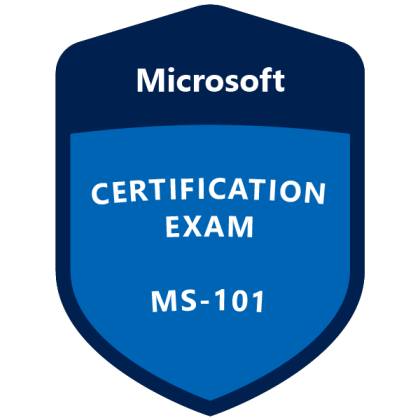MS-101: Microsoft 365 Mobility and Security
Welcome to the MS-101: Microsoft 365 Mobility and Security course! This course is designed for persons who are aspiring to the Microsoft 365 Enterprise Administrator role and have completed one of the Microsoft 365 role-based administrator certification paths. In this MS-101: Microsoft 365 Mobility and Security course, we will cover Microsoft 365 Security and Compliance Manager, Microsoft 365 Device Management, and Microsoft 365 Enterprise Mobility and Security. In Microsoft 365 security management, you'll take a close look at the various attack vectors and data breaches that plague modern businesses, as well as the ways in which Microsoft 365's security solutions counteract these dangers. This course will also help prepare you for the MS-101: Microsoft 365 Mobility and Security exam.Microsoft Courseware
Instructor-Led Training
Course Duration: 5-Day (40-Hour)
Microsoft Official Lab Exercises
Courseware Life Time Free Upgrade
Cloud Lab Access
Overview
This courseware is based on the Microsoft 365 Enterprise Administrator role. The Microsoft 365 Enterprise Administrator has expert-level skills in evaluating, planning, migrating, deploying, and managing Microsoft 365. They perform Microsoft 365 tenant-level planning, implementation, and administration of cloud and hybrid enterprise environments.
The Enterprise Administrator functions as the integrating hub for all Microsoft 365 workloads. This role coordinates across multiple Microsoft 365 workloads, and advises the architects and workload administrators responsible for endpoints, applications, infrastructure, identity, security, and compliance. Microsoft 365 Enterprise Administrators have functional experience with all Microsoft 365 workloads and Azure Active Directory, and have administered at least one of these. They also have a working knowledge of networking, server administration, DNS, and PowerShell.
Modules
Module 1: Explore security metrics in Microsoft 365 Defender
- Examine threat vectors and data breaches
- Explore the Zero Trust security model
- Explore security solutions in Microsoft 365 Defender
- Examine Microsoft Secure Score
- Examine Privileged Identity Management
- Examine Azure Identity Protection
- Lab 1-Exercise 1 – Initialize your Microsoft 365 Tenant
- Lab 1-Exercise 2 – PIM Resource Workflows
Module 2: Manage your security services in Microsoft Defender for Office 365
- Examine Exchange Online Protection
- Examine Microsoft Defender for Office 365
- Manage Safe Attachments
- Lab 2-Exercise 1 – Implement a Safe Attachments policy
- Manage Safe Links
- Lab 2-Exercise 2 – Implement a Safe Links policy
Module 3: Implement threat protection by using Microsoft 365 Defender
- Explore threat intelligence in Microsoft 365 Defender
- Lab 3-Exercises 1 through 4 – Implement Threat Intelligence
- Implement app protection by using Microsoft Defender for Cloud Apps
- Implement endpoint protection by using Microsoft Defender for Endpoint
- Implement threat protection by using Microsoft Defender for Office 365
- Lab 3-Exercises 5 and 6– Implement Threat Intelligence
Module 4: Explore data governance and compliance in Microsoft 365
- Examine governance and compliance solutions in Microsoft Purview
- Explore archiving and records management in Microsoft 365
- Explore retention in Microsoft 365
- Explore Microsoft Purview Message Encryption
- Lab 4-Exercises 1 and 2 – Implement Message Encryption
Module 5: Implement compliance in Microsoft 365
- Explore compliance in Microsoft 365
- Implement Microsoft Purview insider risk management
- Create information barriers in Microsoft 365
- Explore Data Loss Prevention in Microsoft 365
- Implement data loss prevention policies
- Lab 5-Exercises 1 and 2 – Implement Data Governance
Module 6: Manage compliance in Microsoft 365
- Implement data classification of sensitive information
- Explore sensitivity labels
- Implement sensitivity labels
- Lab 6 -Exercises 1 – Implement sensitivity labels
Module 7: Manage content search and investigations in Microsoft 365
- Search for content in the Microsoft Purview compliance portal
- Lab 7-Exercise 1 – Conduct a data search
- Manage Microsoft Purview Audit (Standard)
- Manage Microsoft Purview Audit (Premium)
- Manage Microsoft Purview eDiscovery (Standard)
- Manage Microsoft Purview eDiscovery (Premium)
- Lab 7-Exercise 2 – Investigate Your Microsoft 365 Data
Module 8: Prepare for device management in Microsoft 365
- Explore device management using Microsoft Endpoint Manager
- Prepare your Windows devices for Co-management
- Plan for mobile application management
Module 9: Plan your deployment strategy for Windows devices
- Examine Windows client deployment scenarios
- Explore Windows Autopilot deployment models
- Plan your Windows client subscription activation strategy
Module 10: Implement Mobile Device Management in Microsoft 365
- Explore Mobile Device Management
- Deploy Mobile Device Management
- Lab 9- Exercise 1 through 3 - Manage Devices with Intune
- Enroll devices to Mobile Device Management
- Lab 9- Exercise 4 - Enroll a Windows Device
- Manage device compliance
- Implement endpoint security in Microsoft Intune
- Lab 9- Exercise 5 - Manage and Monitor a Device in Intune
Fees And Schedule
Instructor-Led Training
40-Hour of Instructor-Led Training One to one doubt resolution sessions Microsoft Official Lab AccessLearning Objectives
After completing the MS-101: Microsoft 365 Mobility and Security training, participants will be able to:
- Configure Microsoft 365 Environment
- Set up a Microsoft 365 Tenant
- Tenant management in Microsoft 365
- Effective Microsoft 365 Security Management
- Have an overview of Microsoft 365's Data Governance Features
- The Microsoft 365 Archiving and Retention Process
- Microsoft 365 Intelligence Data Governance Implementation
- The Microsoft 365 Data Governance Management Process
- Administration of Inquiries and Searches Lessons
- Methods for Managing Electronic Equipment
- Determining a Windows 10 Deployment Plan
- Making Use Of Mobile Device Management
Reviews

Dipak Agarwal - Business Analyst at Genpact
Excellent professional & comfortable environment to learn
The training was good, I would like to go through some more training.

Gurpreet Marwaha - IAM Analyst at National Australia Bank, Australia
I learned a lot
Excellent Office 365 training provided by Flexmind
Kiranmai Yachareni - Web Developer at Total Quality Logistics, USA
Excellent ability to clarify all the queries I raised
Thank You! I would definitely recommend it to others. The training session was very informative and interactive. Very useful and definitely thought-provoking. All the module sessions were clear and interactive, great, and friendly. Catered to all levels, which was good for those just starting out and those with more experience. I really appreciate the recorded videos and training material, which would be definitely helpful for later references.

Praveen S (Associate at Grant Thornton LLP)
Excellent knowledge of the trainer on the Subject
I attended PowerApps/Flow training from Flexmind. The topics of the course were well organized & knowledge of the trainer on the subject was excellent. It was very helpful and I will apply in my day to day task at the office. I will definitely recommend a friend or colleague to attend courses from Flexmind.
